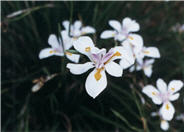
Common name:Butterfly Iris or Fortnight Lily
Botanical name:Dietes iridioides
This clumping evergreen iris bears tall, narrow leaves to 30" tall and white flowers marked purple in the center on stalks to 3' tall, appearing spring through fall. This variety has stiffer, darker foiliage than the bicolor form. It requires sun to part shade with little or no summer watering when established. This is a very reliable plant. Divide every 3-5 years to keep it looking fresh.

Common name:Victor Reiter Thyme
Botanical name:Thymus 'Victor Reiter'
This evergreen ground cover needs full sun to light shade. It grows to 3" tall, forming a dense, thick mat. It needs well-drained, light soil. This thyme is considered drought tolerant. The foliage is dark green and slightly hairy. It has a pleasant, minty fragrance when crushed, though not considered for culinary uses. Flowers are lilac purple and bloom in the summer. It attracts bees and butterflies.

Common name:Sea Pink, Common Thrift
Botanical name:Armeria maritima
This clumping, grass-like perennial is native to many areas, including coastal California. Its flowers range from deep rose pink through white. -Monterey Bay Nursery

Common name:Blue Fescue, Blue Fescue Grass
Botanical name:Festuca glauca
This ground cover/grass will grow less than 1' tall and has small, blue-green, evergreen leaves that are very thin and hair-like. Flowers appear in the summer but are insignificant. This dependable ground cover prefers full sun in coastal areas and afternoon shade in warm inland areas. It needs well draining soil and is drought tolerant once it's established. Leaves may burn during the summer but trim in winter to keep it looking refreshed.

Common name:Freeway Daisy, Trailing African Dai
Botanical name:Osteospermum fruticosum
This groundcover-small shrub will grow 1' tall, spreading 4' in a year. It has medium-size green leaves with lavender that have a dark purple center. The flower color changes to white the next day! The flowers bloom in fall and winter but in mild coastal areas, may bloom all year. It needs well draining soil. This plant looks great on a hillside or in a hanging basket.

Common name:Garden Nasturtium
Botanical name:Tropaeolum majus
This garden annual/groundcover will grow less than 1' tall, but will spread and climb up to 6'. Nasturtium has 2" light green leaves with red, orange, yellow, or white flowers that are in constant bloom throughout the warm season. This plant usually reseeds, with new plants emerging in early spring. This plant does better with regular watering. Some folks put the leaves and flowers in salads!

Common name:Arctotis African Daisy
Botanical name:Arctotis hybrids
African Daisy hybrids grow 12-18" high x 12" wide and produce daisy-like flowers from spring through summer. These hybrids have lobed, gray green leaves and bloom in white, pink, red, purple, cream, yellow or orange. Arctotis likes full sun and well draining soil. It is drought tolerant once it's established.

Common name:Tobira
Botanical name:Pittosporum tobira
This large, dense, evergreen shrub or small tree has shiny dark green leaves. In the spring, clusters of small, cream-colored flowers appear with the fragrance of orange blossoms. Mock Orange can be grown in full sun or partial shade. It is considered one of the most durable shrubs in California landscapes.

Common name:Nandina, Heavenly Bamboo
Botanical name:Nandina domestica
Nandina domestica is a graceful upright shrub that grows from 3'-6' in height. It gets its name from its bamboo-like growth habit. When thinned from the center it bears a remarkable resemblance to bamboo. It is best used in groups. It can be used in a shaded patio or out in a shrub border with full sun. An interesting feature of Heavenly Bamboo is the bronze color in the new growth when planted in full sun. It also bears clusters of white flowers in the spring.
An efficient watering system applies the right amount of water to the right parts of the garden at the right time. This conserves water and saves you money.
Click in the green box for more information
Designer:
Photographer: GardenSoft
Physical weed control, including mulching, or hand removal protects the watershed from harmful chemicals.
Attract, or buy beneficial insects such as ladybugs and lacewings to control pest outbreaks in your garden.